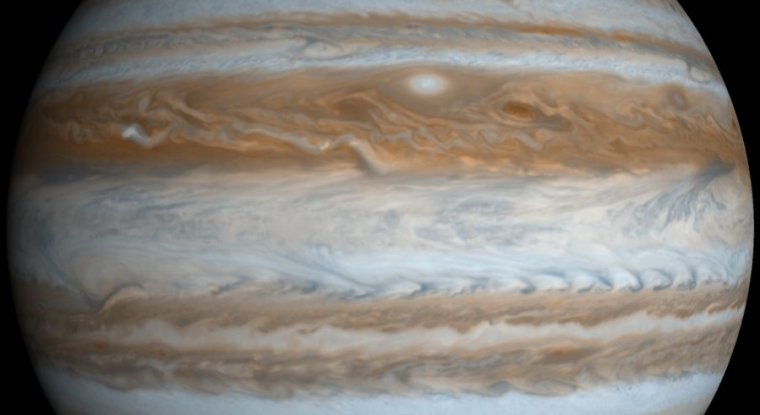New study suggests Jupiter’s formation divided Solar System in twoA solid core would have then started adding gas to create the present planet.
ars Technica
John Timmer - 6/17/2017, 12:05 PM
 NASA
NASAGas giants like Jupiter have to grow fast. Newborn stars are embedded in a disk of gas and dust that goes on to form planets. But the ignition of the star releases energy that drives away much of the gas within a relatively short time. Thus, producing something like Jupiter involved a race to gather material before it was pushed out of the Solar System entirely.
Simulations have suggested that Jupiter could have won this race by quickly building a massive, solid core that was able to start drawing in nearby gas. But, since we can't look at the interior or Jupiter to see whether it's solid, finding evidence to support these simulations has been difficult. Now, a team at the University of Münster has discovered some relevant evidence in an unexpected location: the isotope ratios found in various meteorites. These suggest that the early Solar System was quickly divided in two, with the rapidly forming Jupiter creating the dividing line.
Divide and conquer
Based on details of their composition, we already knew that meteorites formed from more than one pool of material in the early Solar System. The new work extends that by looking at specific elements: tungsten and molybdenum. Molybdenum isotopes serve as a marker of the source material for our Solar System, determining what type of star contributed that material. Tungsten acts as a timer for events early in the Solar System's history, as it's produced by a radioactive decay with a half life of just under nine million years.
While we have looked at tungsten and molybdenum in a number of meteorite populations before, the German team extended that work to iron-rich meteorites. These are thought to be fragments of the cores of planetesimals that formed early in the Solar System's history. In many cases, these bodies went on to contribute to building the first planets.
The chemical composition of meteorites had suggested a large number of different classes produced as different materials solidified at different distances from the Sun. But the new data suggests that, from the perspective of these isotopes, everything falls into just two classes: carbonaceous and noncarbonaceous.
These particular isotopes tell us a few things. One is that the two populations probably have a different formation history. The molybdenum data indicates that material was added to the Solar System as it was forming, material that originated from a different type of source star. (One way to visualize this is to think of our Solar System as forming in two steps: first, from the debris of a supernova, then later we received additional material ejected by a red giant star.) And, because the two populations are so distinct, it appears that the later addition of material didn't spread throughout the entire Solar System. If the later material had spread, you'd find some objects with intermediate compositions.
A second thing that's clear from the tungsten data is that the two classes of objects condensed at two different times. This suggests the noncarbonaceous bodies were forming from one to two million years into the Solar System's history, while carbonaceous materials condensed later, from two to three million years.
Putting it together
To explain this, the authors suggest that the Solar System was divided early in its history, creating two different reservoirs of material. "The most plausible mechanism to efficiently separate two disk reservoirs for an extended period," they suggest, "is the accretion of a giant planet in between them." That giant planet, obviously, would be Jupiter.
Modeling indicates that Jupiter would need to be 20 Earth masses to physically separate the two reservoirs. And the new data suggest that a separation had to take place by a million years into the Solar System's history. All of which means that Jupiter had to grow very large, very quickly. This would be large enough for Jupiter to start accumulating gas well before the newly formed Sun started driving the gas out of the disk. By the time Jupiter grew to 50 Earth masses, it would create a permanent physical separation between the two parts of the disk.
The authors suggest that the quick formation of Jupiter may have partially starved the inner disk of material, as it prevented material from flowing in from the outer areas of the planet-forming disk. This could explain why the inner Solar System lacks any "super Earths," larger planets that would have required more material to form.
Overall, the work does provide some evidence for a quick formation of Jupiter, probably involving a solid core. Other researchers are clearly going to want to check both the composition of additional meteorites and the behavior of planet formation models to see whether the results hold together. But the overall finding of two distinct reservoirs of material in the early Solar System seems to be very clear in their data, and those reservoirs will have to be explained one way or another.
PNAS, 2017. DOI:
10.1073/pnas.1704461114https://arstechnica.com/science/2017/06/new-study-suggests-jupiters-formation-divided-solar-system-in-two/